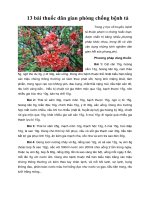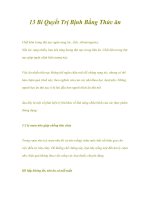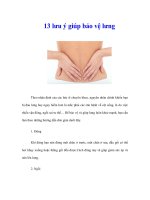13 nutrition recovery carbohydrate 2
Bạn đang xem bản rút gọn của tài liệu. Xem và tải ngay bản đầy đủ của tài liệu tại đây (509.66 KB, 13 trang )
UNIVERSITY
Recovery
Nutrition
Carbohydrate
Requirements,
Performance, Timing and
Sources
Lesson Overview
•
•
•
•
•
•
•
Basic Carbohydrate (CHO) structure and function
CHO effects on hypertrophy and body composition
Are you high CHO or low CHO?
CHO Intake Recommendations
CHO Meal Timing
CHO Periodization
CHO Source Selection
Carbohydrate
Function
Non-essential
Primary and preferred metabolic fuel source in humans (brain, nervous system, red blood cells)
Glycogen storage form in skeletal muscle and liver
Large source of dietary fiber
Micronutrient contribution
Thyroid function
4kcal/g
Types
SIMPLE CARBS
Monosaccharides (glucose, fructose, maltose) honey, milk, fruit, molasses
Disaccharides (Sucrose, Lactose, Galactose) cane sugar, beets, milk, molasses
COMPLEX CARBS
Oligosaccharides (alpha galactosides, beta-fructans) legume, soybean, inulin, FODMOP
Polysaccharides (amylose and amylopectin) plant starch consumed (grains, maltodextrin)
• Fibers
• Res istant starch (potato, grains, oats) *cook your carbs
• Cel l ulose and Hemicellulose (abundant in plants)
• Beta -glucan (oats, barley)
Structure
CHO Effect on Resistance Training
Performance
~80% ATP production during moderate rep resistance training derived from glycolysis
High volume training can deplete glycogen and inhibit calcium release needed for
sustaining muscle contraction
Low glycogen levels large contribute to over training
70% CHO diet no greater performance than 50% CHO diet
25% CHO diet reduced performance
Hypertrophy
Low fat (15%) alter testosterone levels
Low carb (30%) can alter free test: cortisol ratio
High CHO increase insulin for glycogen resynthesis and and glycogen may have direct
effect on intracellular signaling of AMPK and limiting protein break down (anticatabolic)
Improved Pumps and cell swelling
High insulin is needed for sensitization of tissue to localized IGF1
Support positive protein balance
Lower cortisol
Carbohydrate aid sleep
Fat/CHO on Body Composition
In overweight and obese populations, calories equated, the
carbohydrate and fat percentages are not impactful.
Resistance trading performance main driver for muscle retention in a
deficit and will drive what type of weight you lose.
Poor training will lead to great muscle loss and less fat loss
Diets that provide adequate carbs at the expensive of protein cause
greater lean body mass loss
Higher Carbohydrate diets strong partitioning effect for lean/hard
physique indirectly
Ketogenic diets trend toward decrease performance and FFM losses
Are You High Carb or High Fat?
• During exercise and at rest individuals can have 4x the difference in fuel substrate utilization
• Improved insulin sensitivity may lose more weight on high carb diet
• Insulin resistant individuals may lose more on low carb diet
• Low training volume considerations
Advantage high CHO:
Insulin anabolism and anti catabolic
Carbs less readily stored as fat
Fuel anaerobic training
Pumps
Faster digestion and hunger increase
Disadvantage high CHO:
Large food volumes
Higher appetite and hunger
Less palatable
Strict meal planning
• Monitor blood glucose, A1c , and lipid levels for dietary response
CHO intake recommendations
40-60% of total energy needs
Remaining calories 2.5-7 g/kg/day or 1-3+ g/lb/day
*set fat and protein first, remainder CHO
Optimal Protein and Carb Intake should not be compromised by fat
intake
PEDs: Insulin usage does NOT increase CHO requirements
14g of dietary fiber per 1000kcal
Fiber can inhibit some nutrient absorption
Mix of soluble and insoluble fiber
CHO Periodization
Post Show
Highly insulin sensitive on adipose and skeletal muscle
Balance with fat intake for hunger and adherence
Offseason
Low fat intake to increase carb and insulin levels
Contest Prep
Balance between carbs and fats for performance and dietary adherence
Cruise Phase
If insulin resistant via GH/insulin usage, increase fats lower carbs
This may correspond with lower training volume as well
AAS dosage lowered decreases carbohydrate and protein partitioning
CHO Cycling
Increase CHO on training days and weak body parts
CHO Meal Timing
Even spread of CHO during the day
Increase CHO around training AM or PM
• Post cardio
• Peri workout
• 2-day considerations
• Pre-bed
Brain main fuel source is CHO time around studying/work
Simple low fiber carbs around training
Complex carbs within other meals
Digestion comes first! Limit bloating and gas
CHO Source Selections
CHO choices:
Rice Variations
• Cream of rice
• Jasmine rice
• Rice noodles
Potatoes (white, red, sweet)
Oats
Whole wheat and white flour
Other grains (quinoa, spelt, Rye, etc)
Maltodextrin, Dextrose, Branched Cyclic Dextrins
Fruits
Vegetables
Nutrition Summary Recommendations
Nutrition
Recommendations
Carbohydrate
Weekly weight
change
novice/interme
diate
Weekly
weight
change
advanced
Energy
Protein
Fat
Gaining
10-20%
above
maintenance
kcal
1.0-1.5
g/lb/day
0.30.7g/lb
/day
1.0-3.0+
g/lb/day
0.25-0.5% per
week
0.25% per
week to
every other
week
Cutting
20-30%
below
maintenance
1.0-1.5
g/lb/day
0.30.7g/lb
/day
1.0-3.0+
g/lb/day
0.5-1.0% per
week
0.5-1.0% per
week
*During cutting phase limit reducing fat and carb below minimum recommendations
References
Helms ER, Aragon AA, Fitschen PJ. Evidence-based recommendations
for natural bodybuilding contest preparation: nutrition and
supplementation. J Int Soc Sports Nutr. 2014;11:20. Published 2014
May 12. doi:10.1186/1550-2783-11-20
Iraki J, Fitschen P, Espinar S, Helms E. Nutrition Recommendations for
Bodybuilders in the Off-Season: A Narrative Review. Sports (Basel).
2019;7(7):154. Published 2019 Jun 26. doi:10.3390/sports7070154
Schoenfeld B. Science and Development of Muscle Hypertrophy.
Champaign, IL: Human Kinetics; 2021.
Stipanuk M. Biochemical, Physiological, and Molecular Aspects of
Human Nutrition. USA: Elsevier; 2013.









